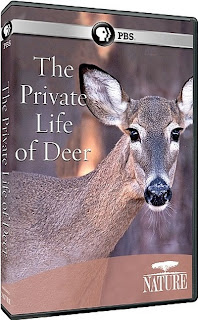PBS first aired the documentary "The Private Life of Deer" on Wednesday May 8, 2013. The show focuses mainly on whitetailed deer.
"Just a century ago, there were less than a million deer in North America. Today, there are nearly 30 million. No wonder it seems they're moving in right down the block. Nowhere are the deer more at home than in the suburbs. Whitetailed deer live in the boundaries, where our backyards meet the backwoods, and the woodlands meet the roads. From our kitchen windows we spot them, nibbling away at our gardens and shrubs.But how well do we know our neighbors from the natural world? Not very well at all, as it turns out. New investigations into their world reveal a more complex society than we imagined. These are smart, adaptable creatures, with impressive skills, senses and family lives, yet they also have unexpected shortcomings. Their famous "deer in the headlights" immobility, for instance, is not caused by fear at all, but rather by bright light overpowering their visual cortex and locking down their brains for a period of up to several minutes. Also among these extraordinary creatures are some exceptional rarities, such as the tiny endangered Key deer that captivate the residents of the Florida Keys, and the spellbinding white ghost deer that roam the northern woods."
* * *
When I first watched the show I thought it was good and maybe there are a few learnings from it. After watching it again online, and probably paying more attention to it, I think it is very good for its overall message. That message is that deer are wild animals and can be desirable. The key is to live with them, and that has always been the motivation behind THINK.
The crux of the problem here in the West is that the elk provide a very potent double whammy. The numbers of deer are or can be bad but they are worse in many other parts of the U.S.
In terms of damage, some takeaways from the program are:
In terms of damage, some takeaways from the program are:
- Deer are extremely adaptable and they do learn. This means they will learn to live with dogs, humans, fences, roads, scarecrows, etc. They clearly learn the limits (i.e., range) of danger. The program didn't mention it: they may learn to accept previously-unacceptable scents.
- Their eyesight is poor (by human standards) hence other senses like smell and hearing are more developed. Per the program, deer can smell "hundreds of yards away." They can see better at night, and especially at dawn and dusk when they feed most often ("extremely good night vision"). They don't see defined shapes, but rather "make out movement."
- They eat a lot: up to seven pounds a day. They will "almost anything," particularly if food is scarce.
- Deer will communicate potential danger to other deer through body movement (e.g., posture, stopping, and tail movement).
- Suburbs and the "edges" are ideal, man-made habitat preferable to woods, plains, etc. Forest clearing creates deer habitat.
- Deer (only bucks?) will mark territory by rubbing (i.e., damaging) trees. Scent is left. The show used the term "buck rub," not "bark rub."
- Mammals tend to be smaller the further south (body heat influence) and in food-scare areas.
- Whitetailed deer (seemingly larger mule deer also) can jump up to eight feet high or more. Jumping is a natural behavior. A six-foot fence is insufficient.
- Deer, particularly males, are most active and most visible during rutting season. Does (females) have a short (5-6 day) breeding period. Birth is approximately eight months after the rut (?). "At just nine months a doe can become a mother" (??). The program didn't deal with facts on this: populations can grow rapidly. Some hundred years ago there were less than a million deer in North America; today there are approximately 30 million.
- In Cayuga Heights, NY deer density is an astounding 100/square mile whereas 5/square mile would be desired or "needed." Residents see "the same deer family year after year" and "most deer spend their entire lives in an area of just one square mile." This is an extraordinary man-made environment.
- "Deer-vehicle collisions comprise most of the mortality" in suburban areas.


